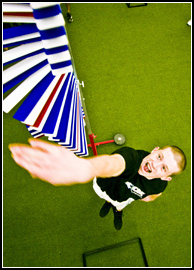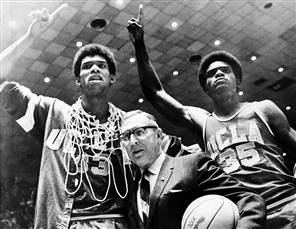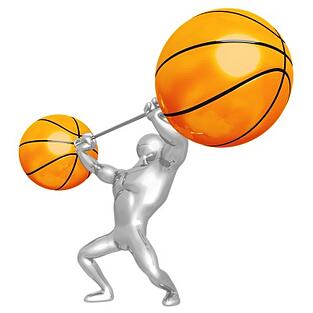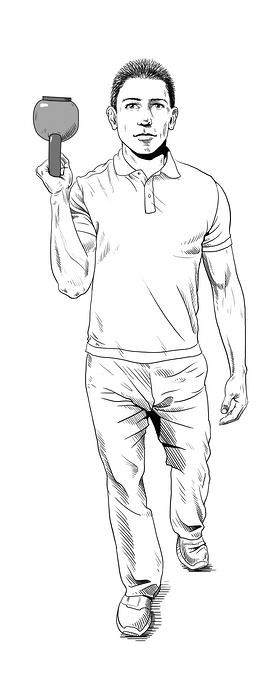Click below to see highlights from our 2013 BSMPG Summer Seminar featuring Marvin Chun.
More highlights are set to come in the next few weeks so stay tuned!
A special thanks again to our SPONSORS!


Posted by Boston Sports Medicine and Performance Group on Mon, Jun 24, 2013 @ 07:06 AM
Click below to see highlights from our 2013 BSMPG Summer Seminar featuring Marvin Chun.
More highlights are set to come in the next few weeks so stay tuned!
A special thanks again to our SPONSORS!


Topics: BSMPG Summer Seminar, Marvin Chun
Posted by Boston Sports Medicine and Performance Group on Wed, Jan 16, 2013 @ 07:01 AM

from Attention and Motor Skill Learning – Gabriele Wulf
“Zachry had participants perform a jump-and-reach task using a Vertec measurement device (see photo). Participants were instructed to jump straight up and touch the highest rung on the Vertec they could reach with the tips of their fingers. Each participant performed five trials under one of three conditions: control, internal focus, and external focus. For the control condition, no additional focus instruments were given. Under the internal focus condition, participants were instructed to concentrate on the tips of their fingers. Under the external focus condition they were instructed to concentrate on the object to be touched, that is, the rungs of the Vertec.
Participants indeed reached higher rungs when they adopted the external focus (on average 4.79 rungs) compared to the internal focus (4.12 rungs) or when they received no attentional focus instructions (4.10 rungs). Also the time they spent in the air was longer under the external (0.491 s) than under the internal focus (0.477 s) or the control condition (0.478 s) Thus a change in the focus of attention significantly affected reach height: Focusing on the object to be touched resulted in more effective performance than did focusing on the finger with which the object was to be touched. Perhaps most interestingly, instructing the participants to adopt an external focus increased jump height above and beyond what participants achieved under “normal” conditions (i.e., control conditions without instructions). These results were recently replicated by Carolina Granados in my lab (Wulf, Zachry, Granados, & Dufek, 2006, Experiment 2). In addition to looking at reach height, Granados calculated the displacement of participants’ center of mass during the jumps. Interestingly, she found not only the greatest reach heights under the external focus condition, but also greater vertical displacements of the center of mass (0.51 cm) compared to those in the internal focus (0.47 cm) and control conditions (0.47 cm).
These findings might seem surprising given that one might expect the jump height to be determined mainly (although not exclusively) by the participant’s strength. Yet we also know, for example, that the coordination between and within muscles influences maximum force production as well (Hollmann & Hettinger, 2000). It is possible tha an external focus optimizes those coordination patterns. While we have to await further research to find out how exactly the attentional focus instructions affected jump height, the findings of this study could have implications for sports in which maximum forces must be generated in a short periods of time (e.g., high jump, long jump, pole vault, basketball layup). In those cases, focusing on the target (e.g., the bar in the high jump) might also result in more effective performance than focusing on movement coordination or not focusing on anything in particular.” Pg 58-59
“The studies we have reviewed in this chapter confirm the anecdotal observation (in windsurfing) that the performance of motor skills seems to be more effective if one focuses on the effects one’s movements have on the environment rather than on the movements themselves. The results from studies using various laboratory tasks as well as sport skills provide converging evidence for the advantage of instructions that induce an external relative to an internal focus. The benefits of an external focus appear to be even more pronounced if the movement effect occurs at a distance from the body, thus making it more easily distinguishable from the body movements that produced it. Furthermore, this effect seems to be rather general and not dependent on individual preferences. In fact, performers often notice immediate changes in their performance as a function of their focus of attention. Importantly, the effects of adopting an external focus when practicing a skill is not just temporary, that is, present only when the individual adopts that focus; rather, these benefits are seen in the retention of the skill and in transfer to novel variations of the skill.” Pg 77
Topics: Charlie Weingroff, Motor Control, BSMPG Summer Seminar, Ben Prentiss, Marco Cardinale, Marvin Chun, Fergus Connolly, Stuart McGill
Posted by Boston Sports Medicine and Performance Group on Thu, Nov 8, 2012 @ 07:11 AM
BSMPG is proud to announce the addition of Charlie Weingroff as a speaker within the Sports Medicine and Rehabilitation Track at the 2013 BSMPG Summer Seminar - May 17th and 18th, 2013! Charlie joins Robert Butler, Dr. Alex Vasquez, and Bill Knowles along with keynote speakers, Dr. Stuart McGill, Marco Cardinale, Fergus Connolly, Adriaan Louw and Marvin Chun for this weekend event. With the most thorough and integrated speaker line-up ever assembled, the 2013 BSMPG Summer Seminar will be the WORLD'S most sought after Sports Medicine & Performance Seminar to date!!
We are expecting the largest crowd in the history of BSMPG events with speakers and attendees traveling the globe to be in Boston in May of 2013, and thus have already made plans to move our main lecture hall to a newly renovated multi-tier auditorium.
Be sure to save the date now - hotels will fill fast with this event along with normal Boston traffic so start making plans now!
See you in Boston next May!!!
CHARLIE WEINGROFF, DPT, ATC, CSCS
Topic: Neurodevelopmental Sequence and Rehab/Training
Charlie is a Doctor of Physical Therapy, a Certified Athletic Trainer, and a Certified Strength and Conditioning Specialist. He was most recently the Director of Physical Performance and Resiliency and Lead Physical Therapist for the United States Marines Corps Special Operations Command in Camp Lejeune, NC. He is also Director of Clinical Education for the Vibraflex Whole-Body Vibration and Andante Medical, the makers of the SmartStep, mobile force plate. He graduated from Ursinus College with a degree in Exercise and Sports Science in 1996, and went on to earn an MSPT in 1999 and DPT in 2010 from the University of Medicine and Dentistry of New Jersey.
Prior to returning to his home state of New Jersey in the Fall of 2006 after 12 seasons of professional basketball, he was the Head Strength & Conditioning Coach and Assistant Athletic Trainer for the Philadelphia 76ers in the NBA. Among the highlights of his tenure in Philadelphia was being part of the medical staff that ranked 1st in the NBA in Player Missed Games in the 2005-06 season.
Through rehabbing patients, he subscribes to a movement-based approach popularized by the works of Dr. Vladimir Janda, Dr. Shirley Sahrmann, Dr. Stuart McGill, and Gray Cook. In training athletes and clients, he champions the principles of the Functional Movement Screen and sound, evidence-based training principles. Some of the methodologies Charlie is formally trained in include DNS, ART, Dry Needling, Graston, FMS/SFMA, and the RKC.
Aside from working with patients, athletes and clients, he is also under the bar himself. In 2007, he achieved AAPF Elite status in the 220 weight class with a total of 1915 pounds. His best powerlifting competition total is 800 squat, 510 bench press and 605 deadlift.
Currently Charlie is training and rehabbing clients of all types at Drive495 in Manhattan, NYC and Fit For Life in Marlboro, NJ.
Charlie lives with his wife, Kristen, and dog, Rumble, in NJ.
Topics: Art Horne, Charlie Weingroff, Stu McGill, Kevin Neeld, Cal Dietz, Bill Knowles, Jeff Cubos, Marco Cardinale, Marvin Chun, Fergus Connolly, Stuart McGill, Rob Butler
Posted by Boston Sports Medicine and Performance Group on Mon, Oct 29, 2012 @ 07:10 AM
BSMPG is proud to announce the addition of Bobby Alejo as a speaker within the Sports Fusion Track at the 2013 BSMPG Summer Seminar - May 17th and 18th, 2013! Bobby joins legendary track coach Randall Huntingon and Ben Prentiss along with keynote speakers, Dr. Stuart McGill, Marco Cardinale, Fergus Connolly, Adriaan Louw and Marvin Chun for this weekend event. With the most thorough and integrated speaker line-up ever assembled, the 2013 BSMPG Summer Seminar will be the WORLD'S most sought after Sports Medicine & Performance Seminar to date!!
We are expecting the largest crowd in the history of BSMPG events with speakers and attendees traveling the globe to be in Boston in May of 2013, and thus have already made plans to move our main lecture hall to a newly renovated multi-tier auditorium.
Be sure to save the date now - hotels will fill fast with this event along with normal Boston traffic so start making plans now!
See you in Boston next May!!!

BOBBY ALEJO
North Carolina State Wolfpack
Assistant Athletics Director for Strength and Conditioning Bob Alejo oversees all of the strength and conditioning efforts of the department, and coordinates the day-to-day efforts of the men's basketball team.
Prior to joining the Wolfpack staff in April, Alejo served as the Director of Strength and Conditioning for the Oakland A's, a position he also held from 1993-2001. In that role, he was responsible for all aspects of the organization's year-round physical preparation at both the major league and minor league levels.
Prior to rejoining the A's, Alejo was the Director of Strength and Conditioning at UC Santa Barbara from 2005-2008. During that time he was also a member of the 2008 U.S. Olympic Team as strength and conditioning coach for the Gold medal-winning men's beach volleyball team of Todd Rogers and Phil Dalhausser.

Topics: Art Horne, Mike Curtis, Stu McGill, Kevin Neeld, Marvin Chun, Fergus Connolly, Stuart McGill, Rob Butler, Bobby Alejo
Posted by Boston Sports Medicine and Performance Group on Mon, Oct 22, 2012 @ 07:10 AM
BSMPG is proud to announce the addition of Kevin Neeld as a speaker within the Sports Fusion Track at the 2013 BSMPG Summer Seminar - May 17th and 18th, 2013! Kevin joins legendary track coach Randall Huntingon and Ben Prentiss along with keynote speakers, Dr. Stuart McGill, Marco Cardinale, Fergus Connolly, Adriaan Louw and Marvin Chun for this weekend event. With the most thorough and integrated speaker line-up ever assembled, the 2013 BSMPG Summer Seminar will be the WORLD'S most sought after Sports Medicine & Performance Seminar to date!!
We are expecting the largest crowd in the history of BSMPG events with speakers and attendees traveling the globe to be in Boston in May of 2013, and thus have already made plans to move our main lecture hall to a newly renovated multi-tier auditorium.
Be sure to save the date now - hotels will fill fast with this event along with normal Boston traffic so start making plans now!
See you in Boston next May!!!

KEVIN NEELD
Sponsored by:
Director of Athletic Development & Athletic Development Coach
Kevin Neeld is the President, COO, and Director of Athletic Development at Endeavor. Since joining the team in 2007 as Endeavor’s Director of Athletic Development, Kevin has rapidly established himself as an international authority on athletic development, with a reputation for creatively applying an extensive knowledge in functional anatomy, biomechanics, neural control, and injury prevention to produce superior results for his athletes.
Kevin is sought after for his expertise in both performance enhancement and injury resistance. He has helped athletes surpass previous performance bests following a multitude of common athletic injuries, including ankle sprains, knee ligament tears, hip labral tears, chronic groin and hip flexor strains, sports hernias, low back pain, shoulder dislocations/separations, and shoulder labral tears.
After completing a successful college hockey career at the University of Delaware ('05-'06: MVP; '06-'07: Team Captain, Lifetime Achievement Award, 2nd Team All-American), Kevin served as the Assistant Coach of the University of Massachusetts Amherst Women's Ice Hockey Team and assisted with the implementation of the strength and conditioning program for the UMass Amherst Men's Ice Hockey Team. Recently, Kevin has joined the US Women's National Hockey Team as a Strength and Conditioning Coach, and has been an invited guest to NHL training camps to assist in the testing and training of the players. Kevin continues his work in ice hockey serving as a coach, educator, and program consultant in the sport.
An accomplished author, Kevin has had articles published in Men’s Fitness and many of the top fitness and performance sites, including AskMen.com, StrengthCoach.com, T-Nation.com, EliteFTS.com, and SportsRehabExpert.com. Kevin is the author of Ultimate Hockey Training, a comprehensive resource on long-term player development and year-round off-ice training methods.
Kevin received his Master’s degree in Kinesiology with a concentration in Exercise Neuroscience from the University of Massachusetts Amherst, and his Bachelor’s degree from the University of Delaware with a major in Fitness Management and a minor in Strength and Conditioning.
Topics: Art Horne, Charlie Weingroff, Kevin Neeld, BSMPG Summer Seminar, Ben Prentiss, Bill Knowles, Jeff Cubos, Marco Cardinale, Marvin Chun, Fergus Connolly, Stuart McGill

Call it deliberate practice, focused resolve, constant repetition, you may call it whatever you like, but I choose to call it the grind. The grind is dressed in street clothes, wears a hard hat and packs a lunch box for a heavy days work! The grind is the long road, a path few choose to travel, marred with obstacles, mountains, valleys and shadows of the many spirits that have given up on their journey. The grind is the best-kept secret to professional success. It never ceases to amaze me that so many people try to bypass the grind to find instant gratification. Coach John Wooden once said: “The quality of the effort is where I found-and continue to find-success.” Success is not pure without sacrifice. For this reason, I am forever grateful for “The Grind.”
- Anthony Donskov, MS, CSCS, PES
Topics: Art Horne, Charlie Weingroff, Ben Prentiss, Bill Knowles, Marco Cardinale, Marvin Chun, Stuart McGill, Bobby Alejo
Posted by Boston Sports Medicine and Performance Group on Thu, Oct 4, 2012 @ 07:10 AM

1. Remain Calm: Yes, it's true that we have the biggest names in Sports Medicine and Performance here in Boston for the 2013 Seminar and it's also true you might never be exposed to so much brain power under one roof ever again. But this is no reason to start dancing around your apartment like a teenage school girl who just met Justin Bieber! Ok, maybe it is.
2. Rest Up: we certainly know how to put on the best seminar in the industry - that's understood. If you've attended an event in the past you know we also know how to put on the best socials in the industry as well. Bring Ibuprofen and a water bottle!
3. Bring Business Cards: We know that you come for the best speakers in the world, but we've also been known to connect sports medicine and performance professionals with the best technology support companies, nutrition experts, and a number of other industry leaders from around the world with one another. We don't want to brag - but we're also responsible for a number of interviews and jobs over the last few years.
4. Take Notes: Not during lectures silly! That's what the powerpoint and outlines we provide you are for. Some of the most powerful conversations take place during our scheduled breaktimes, lunch hours and social events. With the leaders in sports medicine and performance from around the globe present as attendees, some of the biggest Ah-ha moments happen outside the lecture halls. Be ready with pen and paper in hand - you might not get another chance to talk to so many NHL and NBA coaches and therapists as you do at BSMPG!
5. Secure Lodging: During this week many Boston and area colleges and universities host graduations and because of this, area hotels book up fast. We encourage those even thinking about attending to reserve hotel rooms now! You can always cancel the week leading up to the event, but if you wait until the week prior to book, you'll certainly be out of luck. Reserve your room now. See link below.
Click HERE for a complete list of our Hotel Partners.
Recap: Get excited because we are planning the largest BSMPG Seminar to Date - book your travel, get a babysitter, reserve a hotel room, and bring your brain and party pants to Boston!
Let's get it on BSMPG-ers! (yes, that's a Marvin Gaye reference)
See you soon!
Topics: Art Horne, Craig Liebenson, Brijesh Patel, Mike Curtis, Charlie Weingroff, BSMPG Summer Seminar, Cal Dietz, Jeff Cubos, Dan Boothby, Marco Cardinale, Marvin Chun, Fergus Connolly, Stuart McGill, Rob Butler, Clare Frank
Posted by Boston Sports Medicine and Performance Group on Mon, Oct 1, 2012 @ 07:10 AM
If you want to be the Best, then you need to join the Best sports medicine and performance professionals from around the world at the 2013 BSMPG Summer Seminar - May 17th and 18th in Boston MA!
Registration for this event is now open!
Keynote Speakers include: Stu McGill, Adriaan Louw, Fergus Connolly, Marco Cardinale, and Marvin Chun.







Topics: Art Horne, Stu McGill, Ben Prentiss, Bill Knowles, Marco Cardinale, Marvin Chun, Fergus Connolly
Posted by Boston Sports Medicine and Performance Group on Thu, Sep 13, 2012 @ 07:09 AM
by Art Horne

Just recently Dr. Stuart McGill, Jordan Andersen, and I published an article in the Journal of Strength and Conditioning Research examining the link between traditional pre-season strength, fitness, and sports medicine testing to overall on-court basketball performance and injury resilience throughout the course of two collegiate basketball seasons. Although I would be the first to admit that there are some clear limitations to this study (number of participants for example), key performance predictors (points scored, ability to rebound, block shots, etc) were NOT associated with traditional strength or performance measures so often pursued in collegiate basketball strength programs.
Below you’ll read a few of our findings followed by my thoughts on how to best train these attributes that correlated to actual on-court success as well as address common injuries found both in our study and in general among basketball athletes. Findings are in bold, with narrative following in normal text.
First things first. All strength exercises described below must be built on a solid foundation. To quote Gray, “you can’t put strength on dysfunction.”
You wouldn’t build a house on swamp land, so don’t even try to start squatting the basketball athlete before you’ve assessed him for the ability to even perform such a movement with his own body weight. This seems logical to most, but you’d be surprised at the number of coaches who first neglect this fairly obvious rule and bury their athletes under the bar. This rule needs to be applied to all exercises that carry a load, not just the squat. Prove to me that you can handle 1x your body weight and then we can talk about you moving an outside load.
For the sake of argument, we’ll assume the methods below are being applied to a basketball athlete who has been assessed and has passed their movement screen/assessment and has no current pain or past medical condition.
1. A “stiffer” torso leads to better performance
Again, this goes without saying.
Many people automatically associate spine stiffness to side planking for some reason but this couldn’t be further from the truth. The ability to Side Plank or perform a Front Plank are merely two exercises in the large core stability family. Including these traditional exercises along with the chops and lifts, anti-rotation exercises such as the Keiser Belly Press (or Paloff Press), Bird-dog exercises and the Tall Kneeling or standing Single Arm Keiser Chest Press along with Anti-Extension exercises including any variation of roll outs are a staples within any comprehensive yearly training program. But you already knew that – what you may be missing are the following:
a. Rolling - Assessment and activation of the deep core stabilizers: Before addressing the core as described below, one must ensure that the intrinsic musculature immediately surrounding the spine are functioning properly. Assessing rolling patterns in your athletes is an easy check and certainly worth the investment of time. Checking both upper and lower rolling patterns – supine to prone and prone to supine prior to undergoing a long rehabilitation or performance program and addressing deficiency in this area will save you an enormous amount of frustration later on.

b. Carries: This is a must in every rehabilitation and sports performance program – period. I’ve witnessed firsthand athletes returning to competition after a knee injury who were unable to perform a single leg squat on initial evaluation, only to bury it moments after a few minutes of suitcase carries. For sports performance coaches, this has been described by McGill a number of times and specifically to the Yolk walk that strongmen competitors compete in.
“Every time I work with top international athletes I learn more about athleticism. We have all heard that having a strong core increases strength elsewhere in the body. Experience tells us this is true but I was incomplete in my explanation of the mechanism. I enhanced my education a couple of years ago following my analysis of “strongman event” competitors.
First we measured the athlete’s strength capabilities – hip abduction being one of them. Then we quantified the tasks, strength demands and joint mechanics in various events. Curiously they needed more hip abduction strength to succeed in events such as Super Yoke and the Suitcase carry than they could create in their hips. How could they perform a feat of strength that was beyond what a joint could produce?
Consider the Super Yoke where several hundred pounds are carried across the shoulders. The axial load down the spine traverses across the pelvis to the support leg allowing the other leg to step and swing. Hip abduction is needed to lift the pelvis laterally but clearly the strength required far exceeded what the hip could create. The missing strength came from the core muscles (quadratus lumborum and the abdominal obliques on the swing leg side) which helped lift the pelvis. Now consider the footballer who plants the foot on a quick cut. A strong and stiff core assists the hip power to be transmitted up the body linkage with no energy losses resulting in a faster cut. This is the same performance enhancing mechanism as in the Super Yoke but it is not traditionally trained in the weight room.
This experience resulted in the search for the best training approach. We quantified asymmetric carries such as the suitcase carry and found that quadratus and the abdominal wall were challenged to create this unique but essential athleticism. However, working with Pavel we tried kettlebell carries (just in one hand). Racked traditionally with the bell carried on the back of the forearm (with the hand position tucked in close to the chest as if the athlete were to begin an overhead press) helps to reduce shoulder impingement should this be an orthopaedic issue. However, even better was the bottom up carry. Here the bell is held upside down in the bottom up position with the elbow tucked close to the body and the bell beside the head. The core is stiffened to control the bell and prevent it from rotating in the hand. Now walk briskly. Core stiffness is essential to prevent the loss of the bell position.
I consider that every general program to enhance athleticism needs a carry task. “ (McGill, personal communication)

c. Training to Relax: it appears that rate of force development is not the only end to which we should direct our training methodologies. Training to improve RATE OF RELAXATION may be just as, or more important. For additional resources on this subject see below.
d. Breathing through the brace: Spine stiffness is intimately related to diaphragm function, and as such, training the diaphragm to operate as both a Respirator and Stabilizer is of the upmost importance. This is especially important for the Forwards banging down on the post while sucking wind in the fourth quarter. Learn more about “Breathing Through The Brace” and Diaphragm function HERE.
2. Bench Press correlated with blocks per game
Upper body strength is important for basketball – period (at least for the bigs)
Another note on Kevin Durant and others like him: Remember – skill is king. If you are just better than everyone and can score whenever you want, whether you can bench press or not really doesn’t matter. However, if you’re working with a kid that has marginal skill and could use some additional size and strength to compliment this game here are some suggestions for going about doing it that will also have some actual transfer to his performance on the court – and no, none of the suggestions involve bench pressing more. In fact, absolute strength may not be important at all. Sparq Data from 17-19 year olds showed the Power Pass (ability to chest pass a medball) to be highly correlated to those that went on to scholarships and international contracts, whereas NBA draft data from 2007-2009 showed bench press to be one of the lowest! (Nike Sparq data)
Inchworm, Lateral push-ups, Hand Walk-outs, Bear Crawls (forward, back and side to side)
3. Long Jump distance and Lane Agility Test were the most closely linked performance tests linked to actual performance
Let’s break each one of these points down into their individual components.
i. Long Jump scores correlated with: minutes, rebounds, and blocks per game: and thus, an effort must be made to address this horizontal power component in your training program. Here’s how.
Listen, I think basketball athletes should squat and squat often, but unfortunately it often places the basketball athlete into a movement pattern that they perform a thousand times a day already and as such, might not be appropriate for the entire team, all the time as opposed to the deadlift which almost all guys (even guys with knee pain) can perform. If you’re going to squat your athletes (good by the way!), be sure to at least add the deadlift into the mix (and when I say add to the mix, I mean add it a lot!)
Trap Bar Deadlifts are easier to teach and execute than traditional barbell deadlifts from the floor. Holding a bar to the sides is far easier than scraping your shins when holding a bar from the front. We’re not here to teach kids to become great dead lifters, or compete in the Olympics. They’re in your weight room to become better basketball athletes – period. Trap Bar Deadlifts are the fastest, easiest, and safest means to that end.
What’s the goal? Improve basketball motor skills and biomotor abilities that lead to increased basketball court performance while reducing the likelihood of injury.
1.Deadlifting establishes a proper hip hinge pattern which separates your lumbar spine from your hips. If ankle and knee pain don’t end your career, low back pain will. Avoid back pain by mastering this movement and recruiting the massive muscles on your “backside” instead of the muscle in your lumbar spine 2. Holding the bar to the side makes it easier to centrate and “pack your shoulder” joint while also recruiting the large lumbar spine stabilizer called your lats (another great reason to perform this exercise). Teaching kids to “screw in their shoulder” or “pack their shoulder” will carry over to other exercises while also keeping their shoulder joints free from pain. Side note: perform in barefeet to encourage awareness of foot position, strengthen the intrinsic musculature of the foot and ankle, and get them out of those darn basketball shoes for at least a minute.
ii. Lane Agility time correlated negatively with minutes played, points, assists and steals per game (meaning that a faster time was linked to more performance)
i. These are the guys with the stiffer torso’s, the guys that are able to “relax” quickly (again read Cal’s book), and the guys that are able to put force into the ground to change direction. So how do I do this:
iii. Vertical Jump did not correlate with any variable below
Keep working on developing your vertical jumping ability, but not at the expense of developing your skill set. Instead of showing off at between classes with your fancy dunks try spending that extra time at the charity stripe working on your foul shots.
Is any of this really important?
If you’re any one of the 3 major universities in Boston providing basketball scholarships for example, you know that you’ve basically committed over a ¼ of a million dollars towards each athlete by the time they graduate. This doesn’t not even account for the large number of support staff (academic support, athletic trainers, strength coaches, etc.) that invests their time above and beyond to help these young men. If more strength coaches and athletic trainers saw each athlete as a dollar figure, or a loss of potential “revenue” when injured perhaps then each would look to address faulty movement patterns and their contributing factors prior to injury rather than throwing their hands up afterwards in frustration. I don’t think it’s fair to put a dollar figure on an 18 year old kid – but I do think that it’s a nice exercise to clearly illustrate the massive investment institutions are making in their athletes and athletic programs, and one that will resonate with those professionals that provide services to these athletes. Providing sports medicine care means more than applying ice and e-stim after injury and strength & conditioning requires more than simply loading a bar. Both professionals, need to understand that they currently have over 3 million dollars of “product” on their roster right now (13 scholarships), and that their actions and inactions contribute directly to the rise and fall of that value.
Best of luck this coming basketball season!!
References
Dietz C, Peterson B. Triphasic Training: A systematic approach to elite speed and explosive strength performance. 2012.
Nike Sparq Data.
Topics: Stu McGill, Bill Knowles, Marco Cardinale, Marvin Chun, Fergus Connolly
Posted by Boston Sports Medicine and Performance Group on Mon, Aug 27, 2012 @ 07:08 AM
Click below to see highlights from our 2012 BSMPG Summer Seminar featuring Keynote Speaker, Chris Powers.
More highlights are set to come in the next few weeks so stay tuned!
Save the date for the 2013 BSMPG Summer Seminar - May 17th & 18th in Boston MA.
Keynote Speakers include: Dr. Stuart McGill, Dr. Marco Cardinale, Fergus Connolly, Adriann Louw and Marvin Chun. Individual learning track speakers will be announced shortly.
This is sure to be the biggest Sports Medicine and Sports Performance Seminar to date!
A special thanks again to our SPONSORS!
Topics: Stu McGill, Adriaan Louw, Marco Cardinale, Marvin Chun, Fergus Connolly, Rob Butler, Chris Powers
“The residents who live here, according to the parable, began noticing increasing numbers of drowning people caught in the river’s swift current and so went to work inventing ever more elaborate technologies to resuscitate them. So preoccupied were these heroic villagers with rescue and treatment that they never thought to look UPSTREAM to see who was pushing the victims in.”
Learn what is hurting your feet and your performance, and how to finally train your feet the way they were meant to be.
© 2020 Boston Sports Medicine and Performance Group, LLC